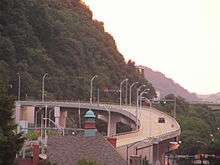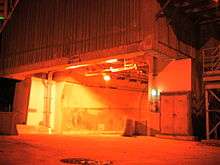Wabash Tunnel
The Wabash Tunnel is a former railway tunnel and presently an automobile tunnel through Mt. Washington in the city of Pittsburgh, Pennsylvania, United States. Constructed early in the 20th century by railroad magnate George J. Gould for the Wabash Railroad, it was closed to trains and cars between 1946 and 2004.[1] The tunnel is arguably the most unreliable tunnel in the city of Pittsburgh, as it continually experiences closures due to malfunctioning gates, malfunctioning signals, electrical failures, and damaged water lines.
.jpg) The north end of the tunnel, which faces downtown Pittsburgh. | |
| Overview | |
|---|---|
| Location | Pittsburgh, Pennsylvania |
| Coordinates | 40.4266°N 80.0172°W |
| Status | in use |
| Crosses | Mount Washington |
| Operation | |
| Work begun | 1902 |
| Opened | 1903 |
| Closed | 1946 |
| Reopened | 2004 |
| Owner | Port Authority of Allegheny County |
| Traffic |
|
| Technical | |
| Length | 3,342 feet (1,019 m) |
| No. of tracks | 2 (1903–1944) |
| Track gauge | 1,435 mm (4 ft 8 1⁄2 in) (1903–1944) |
| Operating speed | 25 mph |
| Tunnel clearance | 13 ft 1 in (3.99 m) |
Operation as a railroad tunnel
Conceived in the late 1800s, the tunnel was built in 1903 for Gould's Wabash Pittsburgh Terminal Railway venture into Pittsburgh, which failed in 1908.[1][2] It carried passenger trains into the city until 1931, and freight trains until 1946.[1][3][4] After the end of train service, the tunnel sat empty for many years. The tunnel was once connected to the Wabash Bridge across the Monongahela River, but this was demolished in 1948,[2] and was not replaced. Its two stone support piers remain in the river.[1]
Conversion to a transitway
In the early 1970s the Port Authority of Allegheny County (PAT) spent US$6 million (US$37.9 million today) rebuilding the tunnel for the never-to-be-operational Skybus people mover system.[1][4] (This project was to include a new Monongahela River bridge.[3])
Use as a bus garage
During this period, the tunnel was used to hold up to 87 of PAT's disused 1950s-era transit buses in reserve.[5] The tunnel portals were reinforced to deter vandals, to the satisfaction of PAT's insurers.[5] Despite this, in 1980, vandals gained access and smashed hundreds of windows and headlights on the two rows of buses parked inside.[4]
Conversion to a roadway


By 1992, the Pennsylvania Department of Transportation (PennDOT) was considering using the Wabash Tunnel as a roadway to compensate for an upcoming closure of the Fort Pitt Tunnel.[4][6] As part of the conversion to a roadway, the guideways for the Skybus system were removed and replaced with new paving and drainage.[4] When awarded in 1994, the contract for this work was worth US$3.2 million (US$5.5 million today).[1][4] However, in 1995, PAT declined to build a new road bridge (estimated at $US25.8 million, or US$43.3 million today) to connect the tunnel with downtown Pittsburgh.[4]
On July 23, 2003 PAT approved contracts for US$10.9 million (US$15.1 million today) to build high-occupancy vehicle (HOV) ramps and modernized the tunnel, as well as provide a 172-space park-and-ride lot along Woodruff Street.[7] The little-used HOV lane was opened on December 27, 2004,[4] running from West Carson Street on the South Side and through the tunnel to Woodruff Street in Mt. Washington. The Fort Pitt Tunnel to the west and the Liberty Tunnels to the east carry nearly all of the vehicular traffic heading downtown.
On November 6, 2013 the Federal Transit Administration lifted the car pool requirements to provide an alternate route for drivers, due to the two-year closure of outbound West Carson Street.[8]
On February 24, 2017 PAT announced that the HOV restrictions had been waived permanently.[9]
Operators

Originally built for the Wabash Railroad, the Pittsburgh and West Virginia Railroad acquired it along with most of the ex-Wabash-Railroad property in 1917.[4]
The tunnel was sold in 1931 to Allegheny County for $US3 million, (US$50.4 million today).[4] The county intended to convert it to a road and use it to relieve the traffic congestion in the Liberty Tunnels, and in 1933 commissioned a $5000 study to investigate this concept.[4]
As of April 2006, the tunnel was operated and maintained for PAT by Bruce & Merrilees, at an annual cost of $780,000.[3]
Incidents
The tunnel's north portal was severely damaged in a 1925 landslide.[4] The tunnel was temporarily closed due to fallen trees on July 19, 2012.[10]
See also
- Wabash Bridge
- Wabash Pittsburgh Terminal – A large railroad terminal that was located in downtown, across the river from the tunnel portal.
- West Busway – the project under which the tunnel was reopened for automobile traffic
References
- Grata, Joe (December 26, 2004), "Wabash Tunnel, closed since 1946, to carry traffic starting tomorrow", Pittsburgh Post-Gazette, Pittsburgh, PA, United States: Block Communications, ISSN 1068-624X, OCLC 44283479, retrieved September 26, 2012,
It will mark the first time for public access since passenger trains quit running through the Wabash Tunnel in 1931, although freight trains used it until 1946. Two stone piers still stand in the Monongahela River from the railroad bridge that once connected the narrow tunnel to Downtown.
- Bennett, Joe (June 5, 1977), "Pittsburgh's Hard-Luck Bridge", The Pittsburgh Press Roto, Pittsburgh, PA, United States: Pittsburgh Press Co., OCLC 2266185, archived from the original on October 3, 2009,
A plan to use the bridge and tunnel as part of a mass transit system into the South Hills had been dropped. Somebody suggested taking the bridge down and putting it up elsewhere. Finally, the old bridge was scrapped and the steel melted down for use in the Dravosburg Bridge that was going up in 1948.
- Grata, Joe (April 25, 2006), "Wabash Tunnel has become expensive venture", Pittsburgh Post-Gazette, Pittsburgh, PA, United States: Block Communications, ISSN 1068-624X, OCLC 44283479, archived from the original on 2011-06-29, retrieved September 26, 2012,
The transit agency pays $780,000 a year to Bruce & Merrilees, a private company, to provide a supervisor and workers. They change gates and signs that control the alternating one-way flow of traffic, monitor closed-circuit video surveillance and carbon monoxide detection systems, respond to accidents, clear snow and handle breakdowns.
- "Wabash Tunnel milestones", Pittsburgh Post-Gazette, Pittsburgh, PA, United States: Block Communications, December 26, 2004, ISSN 1068-624X, OCLC 44283479, archived from the original on 2012-09-29, retrieved September 29, 2012,
The Wabash Tunnel will open for mixed use. That is, car and van pools of two or more people during rush hours, and for all vehicles during off-peak hours. The tunnel is one lane that will be reversed to accommodate traffic flow.
- Grata, Joe (August 1, 1978), "PAT Storing Buses in Wabash Tunnel", Pittsburgh Post-Gazette, Pittsburgh, PA, United States: Block Communications, pp. A-1 & A-4, ISSN 1068-624X, OCLC 10846671, archived from the original on 2016-05-06,
But now PAT has discovered another way to put the tunnel to use — as a parking garage for 87 old buses.
- "The Pittsburgh Press – Google News Archive Search". news.google.com. Retrieved 9 May 2018.
- Port Authority approves garage at South Hills Village Archived 2014-05-23 at the Wayback Machine
- "Wabash Tunnel HOV restrictions lifted – Pittsburgh Post-Gazette". Pittsburgh Post-Gazette. November 6, 2013. Archived from the original on December 21, 2013.
- County, Port Authority of Allegheny. "Port Authority of Allegheny County > News & Events > Latest News". www.portauthority.org. Retrieved 9 May 2018.
- "Downed trees close Wabash Tunnel", Pittsburgh Post-Gazette, Pittsburgh, PA, United States: Block Communications, July 19, 2012, ISSN 1068-624X, OCLC 44283479, archived from the original on 2012-09-20, retrieved September 29, 2012,
Downed trees have closed the Wabash Tunnel and part of Woodruff Street on Mount Washington.
External links
| Wikimedia Commons has media related to Wabash Tunnel. |
- PortAuthority – Overview of the Wabash Tunnel
- 40.4266°N 80.0172°W – Southern portal
- 40.4345°N 80.0094°W – Northern portal
- Wabash Tunnel at www.brooklineconnection.com
- Airport Busway/Wabash HOV Environmental Impact Statement (includes plans for reopening the tunnel for automobile use)
.svg.png)